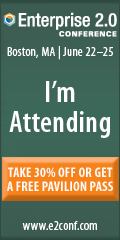The Enterprise 2.0 conference wrapped up in Boston a week ago. Now, it’s pretty interesting to read the conference impressions here and there. Bloggers and journalists made various conclusions about what the major goals, messages and results of the event were. Here are a few picks:
“Broadly speaking, the conference is a vehicle designed to make sense out of the social networking landscape made up of blogs, wikis, customer e-mails, web sites and forums, as well as cloud computing, that is increasingly critical to how business is conducted.” -- W. David Gardner, InformationWeek
“Enterprise 2.0 is not just an event, but one with actual content - and plenty of networking. Oh, if you want to hang around with the rock stars of the social web, they hang there, too.” -- Paul Greenberg, ZDNet
“The key message coming out of this conference? It's not about the deployment of technology, it's about adoption.” --Barb Mosher, CMSWire
“The number UNO issue on the minds of this year’s customer conference attendees was: HOW THE >>>> DO WE DO THIS???” --Susan Scrupski, ITSinsider.
One of the best answers was given in IDEO’s presentation “How to build collaborative software that people will actually use,” or at least it was the answer that’s perfectly aligned with my thinking and doing. Ben Kepes liveblogged his impressions about this presentation at Cloud Ave, and I recommend you have a look at them.
Susan helped to organize Enterprise2Open, where I initiated an interesting discussion on Project Management 2.0. Thanks to those who came and participated in the discussion. It was a valuable experience. I plan to expand my presentation during the upcoming UTD PMI Symposium. It would be great to meet you there and hear your feedback and comments.
Going back to the “how” question, here’s my own summary:
- Use software tools that foster collaboration and are easy to adopt.
- Make sure that new tools integrate with your existing tools (integrate with e-mail) and that new processes build on the foundation of existing processes (evolution instead of revolution).
- Make sure that there’s a core group of adopters who regularly contribute data to the software and spread the best practices.
- Refocus IT efforts from installation of on-premise solutions to integration of on-demand solutions.





